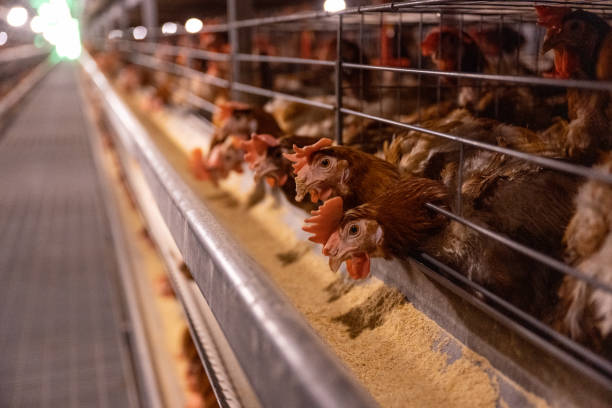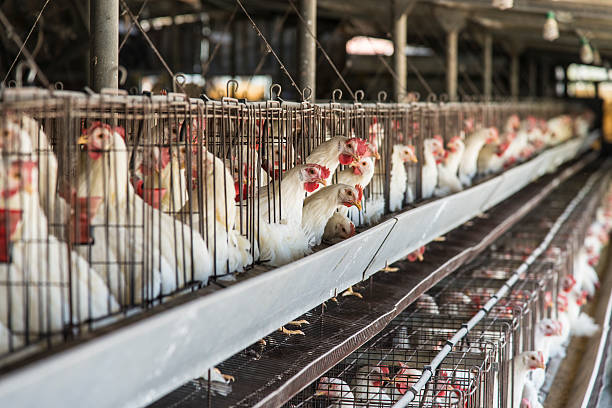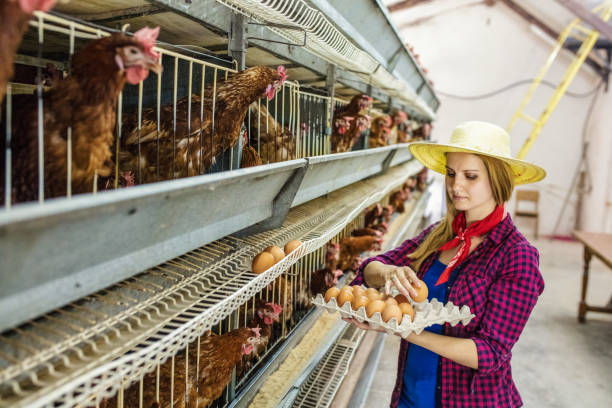# Layer Farm Business Plan for Ghana: Maximize Profits with Modern Cages
Ghana’s poultry industry is ripe with opportunity. The demand for eggs is consistently high, driven by a growing population and changing dietary habits. However, to truly capitalize on this potential, a well-defined layer farm business plan is crucial, and integrating modern cage systems is no longer a luxury, but a necessity for maximizing profitability. This article provides a comprehensive guide to developing a successful layer farm business plan in Ghana, with a specific focus on leveraging the advantages of modern egg-laying chicken cages.

**I. Executive Summary: Your Layer Farm’s Blueprint**
This section serves as a concise overview of your entire business plan. It should briefly cover the following:
* **Business Concept:** The establishment and operation of a commercial layer farm producing eggs for the Ghanaian market. Emphasis on utilizing modern cage systems for improved efficiency.
* **Target Market:** Consumers in [Specific region/city in Ghana], retailers, wholesalers, and potentially institutional buyers (schools, hospitals).
* **Financial Projections:** Summarized highlights of projected revenue, expenses, and profitability over a specific period (e.g., 3-5 years). This should include key metrics like return on investment (ROI) and payback period.
* **Management Team:** Briefly introduce the individuals responsible for the farm’s success and their relevant experience.
* **Funding Request (if applicable):** If seeking funding from investors or financial institutions, clearly state the amount required and its intended use.
**II. Company Description: Setting the Stage**
This section details the legal structure, mission, and goals of your layer farm.
* **Legal Structure:** Specify the legal form of your business (sole proprietorship, partnership, limited liability company, etc.). Consider legal and tax implications when choosing.
* **Mission Statement:** A concise statement defining your farm’s purpose and values. For example: “To provide high-quality, affordable eggs to the Ghanaian market while adhering to sustainable and ethical farming practices.”
* **Goals and Objectives:** Clearly define your short-term and long-term goals.
* **Short-term:** (e.g., Achieve 80% egg production within the first year, secure contracts with local retailers).
* **Long-term:** (e.g., Expand the farm to [number] birds within 5 years, establish a processing and packaging facility).
* **Location:** A detailed description of the farm’s location. Include geographical details, proximity to markets, accessibility to resources (water, electricity), and potential environmental factors. Is the land owned or leased? What are the long-term implications of this decision?
**III. Market Analysis: Understanding the Landscape**
Thorough market research is critical for identifying opportunities and mitigating risks.
* **Industry Overview:** Analyze the current state of the poultry industry in Ghana. Include market size, growth trends, key players, and major challenges. What are the government regulations impacting the poultry industry?
* **Target Market Analysis:** Define your specific target market(s). Who are your ideal customers? What are their needs and preferences regarding egg size, quality, and price? Consider conducting surveys or interviews to gather primary data.
* **Competitor Analysis:** Identify your direct and indirect competitors in the region. Analyze their strengths and weaknesses, pricing strategies, and market share. How will your farm differentiate itself from the competition (e.g., superior egg quality, competitive pricing, exceptional customer service)?
* **SWOT Analysis:** A framework for identifying your farm’s *Strengths*, *Weaknesses*, *Opportunities*, and *Threats*. This helps you assess your competitive position and develop strategies to capitalize on opportunities and address potential challenges.
**IV. Products and Services: Delivering Value**
Clearly define the products and services your layer farm will offer.
* **Eggs:** Specify the types and sizes of eggs you will produce (e.g., standard, jumbo, brown, white). Consider offering specialty eggs like omega-3 enriched or free-range eggs to cater to niche markets.
* **Manure:** Poultry manure is a valuable fertilizer. Develop a plan for managing and potentially selling manure to local farmers or agricultural businesses.
* **Other Potential Services:** Consider offering day-old chicks or pullets to other poultry farmers in the future.
**V. Marketing and Sales Strategy: Reaching Your Customers**
A well-defined marketing and sales strategy is essential for attracting customers and driving sales.
* **Marketing Plan:**
* **Branding:** Develop a unique brand identity for your farm, including a name, logo, and messaging that resonates with your target market.
* **Pricing Strategy:** Determine a competitive pricing strategy that balances profitability with affordability for your target customers. This should consider production costs, competitor pricing, and market demand.
* **Promotional Activities:**
* **Local Advertising:** Utilize local radio, newspapers, and community events to raise awareness about your farm and its products.
* **Digital Marketing:** Create a website or social media presence to engage with customers, share information about your farm, and promote your eggs.
* **Direct Sales:** Consider selling eggs directly to consumers at local markets or through a farm shop.
* **Sales Strategy:**
* **Distribution Channels:** Establish reliable distribution channels to reach your target market. This may include partnering with retailers, wholesalers, or restaurants.
* **Sales Team (if applicable):** If you have a sales team, clearly define their responsibilities and performance metrics.
* **Customer Relationship Management (CRM):** Implement a system for managing customer relationships and tracking sales data.

**VI. Operations Plan: Running the Farm Efficiently**
This section outlines all aspects of your farm’s operations, from sourcing chicks to managing waste.
* **Sourcing Chicks:** Identify a reputable supplier of high-quality layer chicks known for their egg-laying performance and disease resistance.
* **Housing:**
* **Cage System Design:** Detail the type of cage system you will use (e.g., battery cages, enriched cages). Explain the benefits of your chosen system in terms of egg production, bird welfare, and labor efficiency.
* **Cage Specifications:** Specify the dimensions, materials, and features of the cages. Consider factors like ventilation, lighting, and ease of cleaning.
* **Housing Environment:** Describe how you will maintain optimal temperature, humidity, and ventilation within the chicken house.
* **Feeding and Watering:**
* **Feed Management:** Develop a feeding program that meets the nutritional needs of your layers at different stages of their lifecycle. Source high-quality feed from a reliable supplier.
* **Watering System:** Implement a clean and efficient watering system that provides birds with constant access to fresh water.
* **Egg Collection and Handling:**
* **Collection Frequency:** Determine how frequently you will collect eggs to minimize breakage and maintain quality.
* **Cleaning and Grading:** Implement procedures for cleaning, grading, and candling eggs to ensure they meet quality standards.
* **Packaging:** Choose appropriate packaging materials to protect eggs during transportation and storage.

* **Waste Management:**
* **Manure Handling:** Describe how you will collect, store, and dispose of poultry manure. Consider composting or selling it as fertilizer.
* **Water Management:** Implement measures to conserve water and minimize wastewater discharge.
* **Biosecurity:**
* **Disease Prevention:** Implement a strict biosecurity program to prevent the introduction and spread of diseases. This should include measures like controlled access to the farm, regular cleaning and disinfection, and vaccination programs.
* **Pest Control:** Develop a pest control program to manage rodents, insects, and other pests.
**VII. Management Team: The People Behind the Plan**
This section introduces the key individuals responsible for managing the layer farm.
* **Organizational Structure:** Present an organizational chart outlining the roles and responsibilities of each team member.
* **Management Team Profiles:** Provide detailed profiles of each key manager, highlighting their experience, qualifications, and relevant skills.
* **Advisory Board (Optional):** Consider forming an advisory board of industry experts to provide guidance and support.
**VIII. Financial Plan: Show Me the Money**
A comprehensive financial plan is crucial for securing funding and demonstrating the viability of your layer farm.
* **Start-up Costs:** Detail all start-up costs, including land acquisition, construction, equipment purchase (especially egg-laying chicken cages), chicks, feed, permits, and initial operating expenses. Be realistic and conservative in your estimations.
* **Operating Expenses:** Project your monthly and annual operating expenses, including feed costs, labor costs, utilities, veterinary services, marketing expenses, and loan repayments.
* **Revenue Projections:** Forecast your egg production and sales revenue based on your target market, pricing strategy, and expected egg-laying rate.
* **Profit and Loss (P&L) Statement:** Project your profit and loss statement for the next 3-5 years, showing your expected revenue, expenses, and net profit.
* **Cash Flow Statement:** Project your cash flow statement for the next 3-5 years, showing the movement of cash into and out of your business. This is crucial for managing your working capital and ensuring you have enough cash to meet your obligations.
* **Balance Sheet:** Present a projected balance sheet showing your farm’s assets, liabilities, and equity at a specific point in time.
* **Key Financial Ratios:** Calculate key financial ratios like ROI (Return on Investment), Payback Period, and Debt-to-Equity Ratio to assess the financial performance of your farm.
* **Funding Request (if applicable):** Clearly state the amount of funding you are seeking, the terms of the loan or investment, and how the funds will be used. Include a detailed repayment schedule.
**IX. Appendix: Supporting Documents**
Include supporting documents that validate your claims and provide additional information.
* **Market Research Data:** Surveys, industry reports, and other market research data.
* **Supplier Quotes:** Quotes for chicken cages, feed, chicks, and other inputs.
* **Permits and Licenses:** Copies of required permits and licenses.
* **Letters of Support:** Letters of support from potential customers or partners.
* **Resumes of Key Personnel:** Detailed resumes of your management team.
**X. Conclusion: A Path to Success**
A well-developed layer farm business plan is not just a document; it’s a roadmap to success. By carefully considering all aspects of your business, from market analysis to financial projections, and by leveraging the benefits of modern cage systems, you can significantly increase your chances of building a profitable and sustainable layer farm in Ghana. Remember to regularly review and update your business plan as your farm evolves and the market changes. By choosing the right egg-laying chicken cages for your operation, you are already on the path to increased efficiency and profitability. Good luck!






